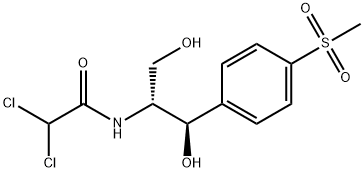
Тиамфеникол
- английское имяThiamphenicol
- CAS №15318-45-3
- CBNumberCB0102588
- ФормулаC12H15Cl2NO5S
- мольный вес356.22
- EINECS239-355-3
- номер MDLMFCD00467983
- файл Mol15318-45-3.mol
химическое свойство
| Температура плавления | 163-166 °C |
| альфа | D25 +12.9° (ethanol) |
| плотность | 1.3281 (rough estimate) |
| показатель преломления | 1.6000 (estimate) |
| температура хранения | Sealed in dry,Room Temperature |
| растворимость | ethanol: 50 mg/mL, clear, colorless |
| Температура кипения | 695.9±55.0 °C(Predicted) |
| пка | 11.05±0.46(Predicted) |
| форма | powder |
| цвет | white to off-white |
| Растворимость в воде | Soluble in acetonitrile or DMF. Slightly soluble in water |
| Мерк | 14,9301 |
| БРН | 2819542 |
| ИнЧИКей | OTVAEFIXJLOWRX-NXEZZACHSA-N |
| Справочник по базе данных CAS | 15318-45-3 |
| FDA UNII | FLQ7571NPM |
| Код УВД | J01BA02,J01BA52 |
| Система регистрации веществ EPA | Thiamphenicol (15318-45-3) |
| Заявления о безопасности | 22-24/25 | |||||||||
| WGK Германия | 2 | |||||||||
| RTECS | AB6680000 | |||||||||
| кода HS | 29414000 | |||||||||
| Токсичность | human,TDLo,unreported,214mg/kg/10D (214mg/kg),BEHAVIORAL: SLEEPGASTROINTESTINAL: NAUSEA OR VOMITINGSKIN AND APPENDAGES (SKIN): "DERMATITIS, OTHER: AFTER SYSTEMIC EXPOSURE",Arzneimittel-Forschung. Drug Research. Vol. 24, Pg. 944, 1974. | |||||||||
| NFPA 704: |
|
рисовальное письмо(GHS)
-
рисовальное письмо(GHS)

-
сигнальный язык
предупреждение
-
вредная бумага
H315:При попадании на кожу вызывает раздражение.
H319:При попадании в глаза вызывает выраженное раздражение.
H335:Может вызывать раздражение верхних дыхательных путей.
H302:Вредно при проглатывании.
-
оператор предупредительных мер
P261:Избегать вдыхания пыли/ дыма/ газа/ тумана/ паров/ аэрозолей.
P305+P351+P338:ПРИ ПОПАДАНИИ В ГЛАЗА: Осторожно промыть глаза водой в течение нескольких минут. Снять контактные линзы, если Вы ими пользуетесь и если это легко сделать. Продолжить промывание глаз.
Тиамфеникол химические свойства, назначение, производство
Химические свойства
Off-White SolidИспользование
Thiamphenicol is an antibiotic. Thiamphenicol is the methyl-sulfonyl analogue of chloramphenicol and has a similar spectrum of activity, but is 2.5 to 5 times as potent. Thiamphenicol is used particul arly for the treatment of sexually transmitted infections and pelvic inflammatory disease.Антимикробная активность
It is generally less active than chloramphenicol, but is equally active against Str. pyogenes, Str. pneumoniae, H. influenzae and N. meningitidis, including some strains resistant to chloramphenicol. It is more actively bactericidal against Haemophilus and Neisseria spp.Приобретенная устойчивость
There is complete cross-resistance with chloramphenicol in those bacteria which elaborate acetyltransferase, although the affinity of the enzyme for thiamphenicol is lower. Organisms that owe their resistance to other mechanisms may be susceptible.Фармакокине?тика
An oral dose of 500 mg produces a peak plasma level of 3–6 mg/L after about 2 h. The plasma half-life is 2.6–3.5 h. It is said to reach the bronchial lumen in concentrations sufficient to exert a bactericidal effect on H. influenzae. Unlike chloramphenicol it is not a substrate for hepatic glucuronyl transferase; it is not eliminated by conjugation, and its half-life is not affected by phenobarbital induction.About 50% of the dose can be recovered in an active form in the urine within 8 h and 70% over 24 h. The drug is correspondingly retained in the presence of renal failure, and in anuric patients the plasma half-life has been reported to be 9 h, a value not significantly affected by peritoneal dialysis. Biliary excretion is believed to account for removal of the antibiotic in anuric patients. The plasma concentration is elevated and half-life prolonged in patients with hepatitis or cirrhosis.
Клиническое использование
Similar to that of chloramphenicol.Побочные эффекты
There are no reports of irreversible bone-marrow toxicity. This has been related to the absence of the nitro group, and hence its reduction products, and differences in the biochemical effects of thiamphenicol and chloramphenicol on mammalian cells. It exerts a greater dose-dependent reversible depression of hemopoiesis and immunogenesis than chloramphenicol, and has been used for its immunosuppressive effect. Therapeutic doses (1–1.5 g) are likely to depress erythropoiesis in the elderly or others with impaired renal function.Методы очистки
Recrystallise thiamphenicol from H2O or CHCl3. The UV has max at 224, 266 and 274nm ( 13,700, 800 and 700) in 95% EtOH. The 1S,2S-isomer [1478651-7] has m 164.3-166.3o (from H2O/EtOAc/pet ether) and [] D 25 -12.6o (c 1, EtOH); and the racemate 1RS,2RS-Racefenical [847-25-6] has m 181-183o (dec) from CHCl3/EtOAc/pet ether. [Cutler et al. J Am Chem Soc 74 5475, 5482 1952, UV: Nachod & Cutler J Am Chem Soc 74 1291 1952, Suter et al. J Am Chem Soc 75 4330 1953, Cutler et al. J Am Pharm Assoc 43 687 1954, Beilstein 13 IV 2957.]Тиамфеникол запасные части и сырье
Тиамфеникол поставщик
| поставщик | телефон | страна | номенклатура продукции | благоприятные условия |
|---|---|---|---|---|
| +8615531157085 | China | 8804 | 58 | |
| +86-029-81138252 +86-18789408387 |
China | 3889 | 58 | |
| +86-13131129325 | China | 5887 | 58 | |
| +86-0311-87836622 +86-17333973358 |
China | 8051 | 58 | |
| +86-53169958659 +86-13153181156 |
China | 294 | 58 | |
| +86-17331933971 +86-17331933971 |
China | 2472 | 58 | |
| +8618092446649 | China | 1143 | 58 | |
| +86-18239973690 +86-18239973690 |
China | 311 | 58 | |
| +86-16264648883 +86-16264648883 |
China | 3712 | 58 | |
| +86-(0)57185586718 +86-13336195806 |
China | 29792 | 60 |